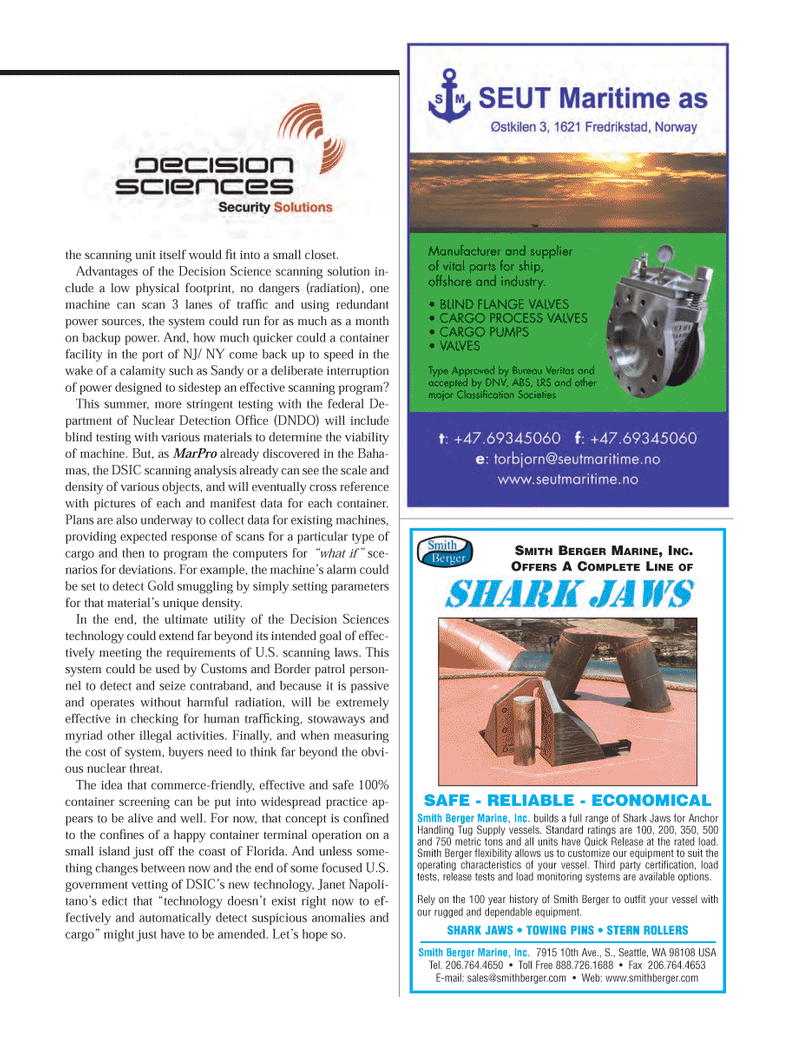
Page 39: of Maritime Logistics Professional Magazine (Q1 2013)
Maritime Risk
Read this page in Pdf, Flash or Html5 edition of Q1 2013 Maritime Logistics Professional Magazine
Smith Berger Marine, Inc.builds a full range of Shark Jaws for AnchorHandling Tug Supply vessels. Standard ratings are 100, 200, 350, 500 and 750 metric tons and all units have Quick Release at the rated load.Smith Berger flexibility allows us to customize our equipment to suit theoperating characteristics of your vessel. Third party certification, loadtests, release tests and load monitoring systems are available options. Rely on the 100 year history of Smith Berger to outfit your vessel with our rugged and dependable equipment.SMITHBERGERMARINE, INC.OFFERSA COMPLETELINEOF SHARK JAWS ? TOWING PINS ? STERN ROLLERS Smith Berger Marine, Inc.7915 10th Ave., S., Seattle, WA 98108 USA Tel. 206.764.4650 ? Toll Free 888.726.1688 ? Fax 206.764.4653 E-mail: [email protected] ? Web: www.smithberger.com SAFE - RELIABLE - ECONOMICALthe scanning unit itself would Þ t into a small closet. Advantages of the Decision Science scanning solution in- clude a low physical footprint, no dangers (radiation), one machine can scan 3 lanes of trafÞ c and using redundant power sources, the system could run for as much as a month on backup power. And, how much quicker could a container facility in the port of NJ/ NY come back up to speed in the wake of a calamity such as Sandy or a deliberate interruption of power designed to sidestep an effective scanning program? This summer, more stringent testing with the federal De- partment of Nuclear Detection OfÞ ce (DNDO) will include blind testing with various materials to determine the viability of machine. But, as MarPro already discovered in the Baha- mas, the DSIC scanning analysis already can see the scale and density of various objects, and will eventually cross reference with pictures of each and manifest data for each container. Plans are also underway to collect data for existing machines, providing expected response of scans for a particular type of cargo and then to program the computers for ?what if? sce-narios for deviations. For example, the machineÕs alarm could be set to detect Gold smuggling by simply setting parameters for that materialÕs unique density. In the end, the ultimate utility of the Decision Sciences technology could extend far beyond its intended goal of effec- tively meeting the requirements of U.S. scanning laws. This system could be used by Customs and Border patrol person-nel to detect and seize contraband, and because it is passive and operates without harmful radiation, will be extremely effective in checking for human trafÞ cking, stowaways and myriad other illegal activities. Finally, and when measuring the cost of system, buyers need to think far beyond the obvi- ous nuclear threat.The idea that commerce-friendly, effective and safe 100% container screening can be put into widespread practice ap-pears to be alive and well. For now, that concept is conÞ ned to the conÞ nes of a happy container terminal operation on a small island just off the coast of Florida. And unless some- thing changes between now and the end of some focused U.S. government vetting of DSICÕs new technology, Janet Napoli- tanoÕs edict that Òtechnology doesnÕt exist right now to ef- fectively and automatically detect suspicious anomalies and cargoÓ might just have to be amended. LetÕs hope so. MP #1 34-49.indd 39MP #1 34-49.indd 392/22/2013 11:18:18 AM2/22/2013 11:18:18 AM

 38
38

 40
40
